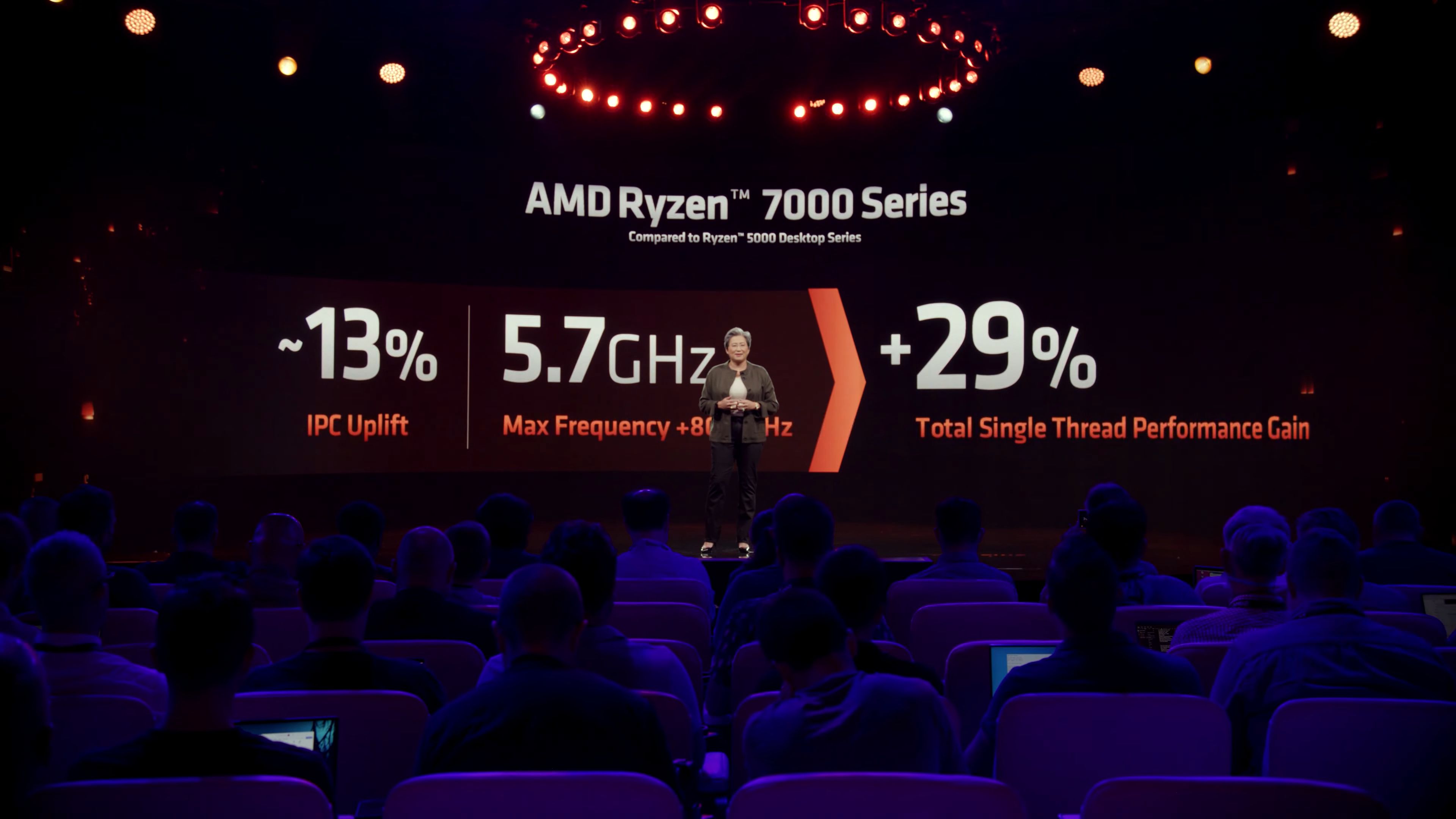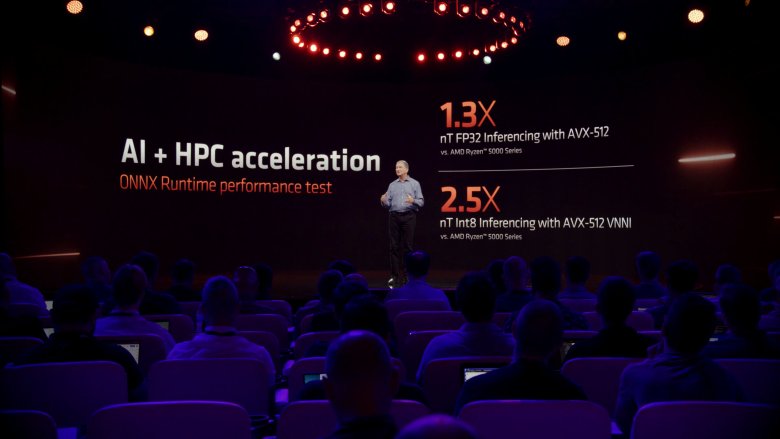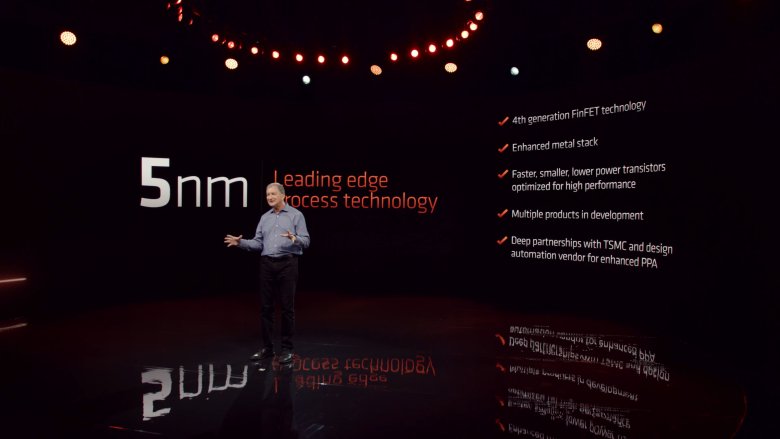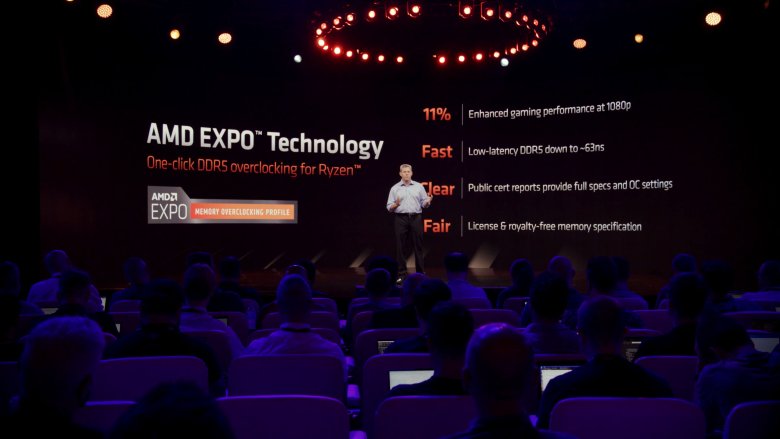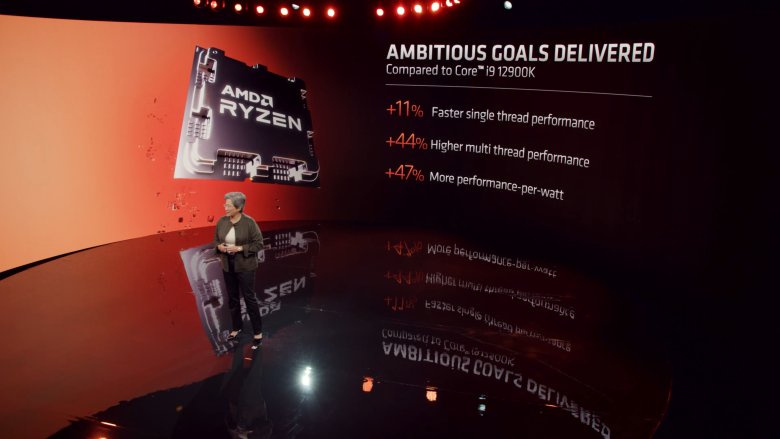Processor core Zen 4 it was created by the evolution and reworking of the core Zen 3. They offer a 13% increase in CPI in desktop applications, with most of the increase coming from a redesigned front-end processor.
In server applications, the increase in IPC can be significantly greater due to the implementation of support for AVX-512 instructions, where even a 30-150% shift can be achieved:
An important goal was to optimize the x86 core design for the lowest possible area, and not just using the 5nm TSMC process. The result is that the kernel Zen 4 including L2 cache reaches half of the core area Alder lake (Golden Bay) including L2 cache. At the same time, it offers nearly half the energy efficiency.
We can stay with that. We’re just moving from the core comparison to the full processor comparison – Ryzen 9 7950X versus Ryzen 9 5950X. With the 65 W TDP setting, you get 74% more power, with 105 W TDP 37% more power and with 170 W TDP 35% more power. Among other things, this says a lot about what performance changes can be expected in notebook models.
When the Ryzen 9 7950X is set to perform like the Ryzen 9 5950X, it manages to do so with 62% less power. When set to achieve the same consumption, it offers 49% more performance.
How they perform in factory settings: In gaming tests, the new flagship model achieves 6-35% higher performance than the current one. In multi-core application performance, 30-48% higher performance is achieved between generations.
Get over it Alder lake / Core i9-12900K gaming performance ranges from -1 to + 23% and multi-core applications from 36 to 62%.
Particularly in V-Ray, where the displacement is the highest, the Ryzen 9 7950X offers 62% higher performance and 47% higher energy efficiency.
In terms of gaming performance, the Core i9-12900K outperforms the traditional Ryzen 5 7600X by an average of 5%.
Fans of single-core scores in the GeekBench test, where the Ryzen 7000 outperforms the Core i9-12900K by 7-12%, could also benefit.
As for the platform, the existence of the B650E has been confirmed, bringing the range of configurations to four. However, compared to the original reports, the difference is that the X670E / B650E guarantees PCIe 5.0 support on the interface for graphics and storage, while the X670 / B650 guarantees only PCIe 5.0 support on storage.
Twelve brands are preparing PCIe 5.0 storage, the first of which will be available in November this year.
EXPO memory DDR5 profiles (originally named RAMP) are also confirmed, and at least 15 DDR5 kits will be ready for the September release that will support EXPO.
Prices for the motherboard will start at an MSRP of $ 125. Lisa Su also confirmed that the AM5 socket will be available until at least 2025.
The Ryzen 9 7950X is expected to outperform the Core i9-12900K in single-core performance by 11%, multi-core by 44% and power-to-watt ratio of 47%.
While the specifications of the individual models have been confirmed as presented by the leakers, no source has confirmed the prices. While in the higher price range, according to some, the price should have ended at $ 799, and according to others, even significantly higher, officially the Ryzen 9 7950X will cost $ 699, which is less than what it cost at the launch of the Ryzen 9 5950X. In the case of the Ryzen 7 7700X, the sources were extremely divergent, with some claiming $ 299, others $ 449. The official price will be $ 399. Sales will begin in less than a month, on September 27th.
| Ryzen | core train. |
rate / increase | L3 | TDP | cooler Spectrum |
dinner | |
|---|---|---|---|---|---|---|---|
| R9 | 7950X | 16/32 | 4.5 / 5.7 GHz | 64 MB | 170 W | – | $ 699 |
| 5950X | 16/32 | 3.4 / 4.9 GHz | 64 MB | 105 W | – | $ 799 | |
| 7900X | 24/12 | 4.7 / 5.6 GHz | 64 MB | 170 W | – | $ 549 | |
| 5900X | 24/12 | 3.7 / 4.8 GHz | 64 MB | 105 W | – | $ 549 | |
| 5900 | 24/12 | 3.0 / 4.7 GHz | 64 MB | 65 W | – | OEM | |
| R7 | 5800X3D | 8/16 | 3.4 / 4.5 GHz | 96 MB | 105 W | – | $ 449 |
| 5800X | 8/16 | 3.8 / 4.7 GHz | 32 MB | 105 W | – | $ 449 | |
| 5800 | 8/16 | 3.4 / 4.6 GHz | 32 MB | 65 W | – | OEM | |
| 7700X | 8/16 | 4.5 / 5.4 GHz | 32 MB | 105 W | – | $ 399 | |
| 5700X | 8/16 | 3.4 / 4.6 GHz | 32 MB | 65 W | – | $ 299 | |
| 6700G | 8/16 | ~ 4 / ~ 4.7 GHz | 16 MB | 65 W | Invisible | $ 279 | |
| 5700G | 8/16 | 3.8 / 4.6 GHz | 16 MB |
65 W | Invisible | $ 359 | |
| 5700GE | 8/16 | 3.2 / 4.6 GHz | 16 MB | 35W | – | OEM | |
| R5 | 7600X | 6/12 | 4.7 / 5.3 GHz | 32 MB | 105 W | – | $ 299 |
| 5600X | 6/12 | 3.7 / 4.6 GHz | 32 MB | 65 W | Invisible | $ 299 | |
| 6600G | 6/12 | ~ 4 / ~ 4.5GHz | 16 MB | 65 W | Invisible | $ 199 | |
| 5600G | 6/12 | 3.9 / 4.4 GHz | 16 MB |
65 W | Invisible | $ 259 | |
| 5600 | 6/12 | 3.5 / 4.4 GHz | 32 MB | 65 W | Invisible | $ 199 | |
| 5600GE | 6/12 | 3.4 / 4.4 GHz | 16 MB | 35W | – | OEM | |
| 5500 | 6/12 | 3.6 / 4.2 GHz | 16 MB | 65 W | Invisible | $ 159 | |
| R3 | 5300G | 4/8 | 4.0 / 4.2 GHz | 8 MB | 65 W | – | OEM |
| 5300GE | 4/8 | 3.6 / 4.2 GHz | 8 MB | 35W | – | OEM | |
Among other things, there was also an updated roadmap of the processor cores until 2024:
Nuclei Zen 5 they will be produced in various products with both 4 nm and 3 nm processes. Again, the V-cache variant of processors is also considered Zen 5c, that is a more compact version of the core, which at the expense of slightly reduced frequencies and thanks to various optimizations will bring a significantly higher number of cores in server configurations. All of this will be released by the end of 2024 (or so AMD believes).
–
